 |
 |
 |
 |
 |
 |

|  |
 |
 |
 |
 |
 |
 |
 |
 |


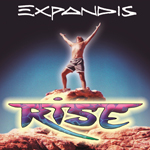
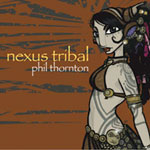
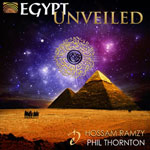
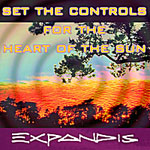

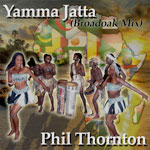

 |
|
Mysteries of Heaven and Earth
An Interview with Phil Thornton by Serge
Kozlovsky and Alexander Petrov - May, 2001 |
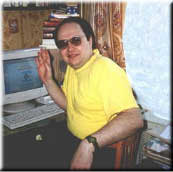 |
Alexander: Could you tell us about your way to music, your musical roots and foundations? How did your musical career begin? Maybe your family influenced your choice, or maybe the music you listened to in your childhood inspired you? Phil: I come from a musical family, my sister played the organ at the local church, my brother played organ and guitar in a group and my mother played the piano accordion in a dance band. When I was 9 years old she encouraged me to take up the accordion and join the band. By the time I was 14 I was getting interested in rock music ( The Who, Jimi Hendrix etc..) and so I started playing guitar, trying to get a group going and do my first gigs. A couple of years after this I heard music by artists such as - Genesis, Tomita, Pink Floyd and Gentle Giant. I fell in love with the sound of the mellotron an early sample keyboard based on tapes!) and soon found a way to make a similar sound on the cheap! (an elka rhapsody with modifications and old guitar pedals!) By the time I was 17 I had got myself into my first full time band, playing a type of progressive rock influenced by the above groups, for the next 3 years I learnt how to survive on the road and write original music with the rest of the band ! ( there is some more info on my web site about this group, look for 'Glow Pony') Alexander: It is interesting for us to know about the story of creation of your first album and your first group. Phil: By 1980 I had become frustrated by the limitations
of life in a rock group, and so I set about forming a new type of group
or 'collective'.
The result was 'Expandis' formed with John Wilde on vocals and Dave Miller on guitar, both of which I had played with in previous bands. The idea was to concentrate on recording and writing but also create a strong live act. I was becoming more and more interested in electronic music at this time so we decided to use synthetic sounds for the drums and bass which kept the size of the band down and concentrated the creative energy into new directions. The result was a formula which was suitably open ended and experimental! Our recordings ranged from pure synth pop through to some very strange sound sculpting! As soon as we had enough material for an album, we put together a cassette (I'm not waving I'm drowning) which we sold at gigs. This album was later released by underground music. Serge: Why do you have such a deep interest to the culture, mythology, attributes and artifacts of Egypt? For example, on your web site one can see links in the form of pyramids. And to the point it is interesting to know about your work on the albums Eternal Egypt, Immortal Egypt and Pharaoh. I had an interest in the pyramids long before I knew anything about modern Egypt. I have always been intrigued by the stories of energy being trapped in this shape. This interest led me to the discovery that the 'tetrahedron' (3 dimensional triangle with equal sides and angles) is not the same as the shape of the Egyptian pyramids. This shape however is the strongest form possible with all lines of force meeting in the centre ! This is the shape represented on the web site, and continues to be a great source of inspiration through the use of guided meditation and visualisation. The first thing which really inspired me with Egypt was the music! I had been interested in stories of ancient Egypt and the pyramids before this but when I heard music such as 'Songs from the victorious city' by Anne Dudley and Jaz Coleman and 'Passion' by Peter Gabriel I became a real fan. There are so many sounds in their music which are unique. The scales used can create a mood which takes you beyond minor or blues and into a rich alien vocabulary. When I had the chance to stay in Cairo while recording for the Immortal Egypt album I fell in love with the people and culture of Egypt. Please tell us about your collaboration with Hossam Ramsy. How did you come to the mutual work on Immortal Egypt? As we know from the album information, Hossam Ramsy is a famous artist, who worked with the Rolling Stones, Page and Plant and Peter Gabriel. Hossam had been recording with James Asher, so when I was working at James's studio in London his name came up in conversation. As a result James was able to introduce me to Hossam. At first I approached him with the idea or asking him to come and do a session for me but when we got together to discuss this, the idea of writing together became a better choice! Hossam was on a major world tour at the time so while working with him on Eternal Egypt I became inspired with the Pharaoh concept which turned out to be a less 'Egyptian' sound. This album was released first which became a good introduction for Eternal Egypt. A couple of years later we were offered a better budget to record a follow up, the result was 'Immortal Egypt' which I think is my most adventurous world music album collaboration to date. In general, with which artists do you collaborate, and in particular, do you have any collaboration (and possibly friendly relations) with the New World Music artists? Do you have friends among artists and maybe you are planning any joint projects in the near future? In general, who are your favourite artists? The New World artist I know best would be Asha, we have worked together on most of his albums, sometimes working in my studio and sometimes working at either James Asher's studio or at Anthony Phillips (ex Genesis guitarist ) studio. I have also recorded two albums with Steven Cragg, 'Initiation' and 'Tibetan Horn'. A couple of years ago I was invited to perform at the 'Simply Relax' festival in Amsterdam where I had the chance to meet up with New World artists Philip Chapman, Serge Douw and Stuart Jones as well as many other musicians from across Europe including a great didgeridoo band 'Circular Breathing' from Berlin. I keep in contact with most New World artists via e-mail and telephone but, as gigs are so rare, most musicians I know tend to stay in their studios. I have been involved with a Brighton band (Mandragora) for many years as producer and occasional synth player. They enjoy bringing world influences to their music so they have become a great source of new contacts for me. When I am able to join them at festivals the inspiration becomes even stronger as I then have the input from other acts as well. Mandragora have just started a new venture called 'Organic Audio', inspired by Peter Gabriel's 'Real World' ethnic recording sessions, it is a way for exotic musicians around the south of England to work together and do some networking. I am looking forward to developing this venture over the coming months. I think my favourite New World artists would be - Medwyn Goodall, Stuart Jones, Terry Oldfield, Asha and James Asher. You had a possibility to work with famous artists and groups. Maybe you can recollect some interesting (and maybe funny) episodes from this work? What collaborations are most precious for you? I have great memories of the 'Pink Pop' festival in Holland, playing keyboards for Sinead O'Connor in front of 80,000 people! The shared atmosphere when she played a solo version of 'Troy' was electric to say the least! One of the strangest jobs I have ever had as a musician was playing keyboards for the 70's pop band 'Bay City Rollers', this was long after their superstar phase, calling themselves the 'New Rollers'. The gigs were usually at a university or night club, packed with fanatical supporters! On one occasion I got quite scared as there was little security and the audience were about 90% mad as hatters, trying to storm the stage and rip the band to pieces! We had to escape via the toilet window in the dressing room! Some of my favourite memories of gigs are of the 'performance art' variety, Arthur Brown appearing on stage with Mandragora and creating a powerful energy with the audience would be one, or an improvisation with Tete Espindola at a seminar in Brazil, where the audience (of around 1200) had such a look of surprise as the music became a bit more 'experimental' than they expected! Could you tell us about your interest to Tibetan theme, and the work on your album Tibetan Horn? What place does this album have in your discography? Are you planning to do something in this direction? After working on the album 'Initiation' with Steven Cragg, I was inspired by the musical possibilities that were opening up. As we were both keen to try a full scale collaboration and he had acquired a Tibetan horn at a second hand shop in Brighton this became a natural starting point. His keen interest in Tibetan culture led the way with creating the various atmospheres on the album. Using carefully selected samples of chanting monks, percussion sounds and a session from a Tabla player the album was built up in sections and then pieced together. In the end the album was 2 years in the making ! no stone was left unturned in finding the right path for the music to follow. I have a particular passion for albums with a 'journey' theme and this album remains a firm favourite. Steven is away travelling at the moment (having got fed up with the dull weather !) so if I do a follow up to 'Tibetan Horn' I will probably be working alone. After the Egyptian cycle you turned your attention to the theme of the myths and legend of Celtic civilisation, and created the album Solstice. Could you tell us why did you turned to this topic and how did you work on the album? The paganistic roots of Solstice should not be confused with an even older and more basic feeling of respect for the never ending seasons cycle and the rising of our Sun. The marking of the longest and shortest days of the year would seem to be the most natural way to show our respect for this wonderful living and breathing planet. My own experiences of Solstice at Stonehenge indicate to me that the monument continues to be a focal point for a not dissimilar spirituality to that which it was created to celebrate. The fact that now it is celebrated in a non-conformist way, would seem to me to be very healthy. Although I count several confirmed Pagans and Druids as close friends, neither they nor I would consider me Pagan or Druid. What we do share is a vision of a living planet and the need to celebrate its beauty and power. As I write this I can look up at a testimonial hanging on the studio wall. It was presented to my Grandfather in recognition of sixteen years service to his local Druidic chapter (a Victorian revival) Although I did not know my Grandfather well, my awareness of his testimonial led me to inquire about the Solstice at a very early age. My first experiences of live playing (original material) was on the free festival circuit of the mid '70s. At this time the Stonehenge / Solstice festival was the highlight of my musical year. Likewise I've been taking part in the Lewes (cliffe) and Battle (battel) bonfires since the late sixties. These events are connected to many local traditions but the connection with the Celtic festival of Samhain is to my mind only just below the surface! In my daily life, my love of nature is constantly affirmed by my surroundings - walking my great Dane on the local beach and surrounding woods and marshland. Plus the odd spot of stargazing! We can not but ask you about the album Alien Encounter, which is possibly most mysterious in your discography. How did you manage to produce such a mysterious sounds which we hear in the album? In general, do you have an interest to paranormal phenomena, aliens, UFOs and mysteries of Space? In general, are you interested in any spiritual techniques and training? Please, tell us about it. I am very interested in all these subjects, especially Science and Astronomy, E=MC2 is more than enough for me to try to understand fully never mind so called 'mysteries'. Although I am a fan of good science fiction, I find most comments made about the paranormal hard to take ! I think it is true that as we learn more about the Universe we are confronted with even more questions! but when people say things like - 'the Earth was created 6000 years ago, and fossils / geology are God's trick to test the faithful' I find it very difficult to take seriously. As for spiritual techniques, I would say these disciplines are also of great interest and I have great respect for people who have a chosen spiritual path, but any act of faith that requires one to blindly follow a leader is not for me! I do use my own techniques in meditation and visualisation ( for help in relaxation and creativity ) such as the tetrahedron visualisation mentioned earlier but how this would relate to any specific formal techniques I could not say. When I was first asked to record the album 'Alien Encounter' I had the feeling it would be an easy project ! (This was after all not the first time I had come across the subject). However when I began working on the music it became apparent that there were a lot of subtleties which would need attention. I'm particularly pleased with some of the effects I ended up using, for instance I have been told the 'clicking' sounds resonate with people who have experience in this area ! finding 'other world' type sounds without resorting to cliches or too many gimmicks was a challenge to say the least ! I did however use some backwards talking at one point ! ( my 7 year old son talking about 'watching the skies'). The whole of the first half of the album has a 'flow' which, as a listener I find very evocative of the sort of 'inner journey' which is a constant source of inspiration for me. track 3 - 'another blue light' was built up around a sample loop taken from the song of the same name from the Expandis album 'The Complete Home Expandis' written by Dave Miller. The original track is a very haunting but positive ballad which is concerned with the loss of a friend or loved one through death. I remember playing this track at gigs where so much energy was created that it was almost too much to continue! Strong emotions being carried to the surface! Somehow the atmosphere produced transcended any feelings of loss. Hopefully a small hint of those emotions have been distilled into a positive feeling of hope that we are not alone. What are your further creative plans, with what directions are they connected? I am planning a new album for New World Music with the working title 'Dreams'. This is a subject I have been interested in for many years. I am hoping this new album will be released in cd-rom format with useful information for people who wish to explore the meaning of their dreams. Asha (another New World artist) is trained in dream therapy and during the years that I worked with him in the studio I picked up on his enthusiasm for the subject, learning enough to inspire this new project. I am also working with Simon Williams from Mandragora on the 'Organic Audio' project which has already become very inspiring, with new musical influences such as Eastern European violin and Turkish Saz being bought together in the studio. Could you tell us about the musical instruments, which your are usually using in your work. Where do you record your albums? What are your favourite instruments? When I'm recording, the bulk of the work would be in arrangement and structure. The actual performance might take up a relatively small amount of time, with an improvisation towards the end of the process. At this stage I find my e-bow guitar, a good synth sound or one of my recorders to be most expressive. It would be difficult to single out an instrument as being more important than the others as I tend to approach the whole studio as a single instrument, particularly the 'midi' set up! The approach to recording in my home studio can be quite experimental! (I have been known to rewire most of the studio to get a particular sound or effect!) The computer allows me to explore some interesting techniques - such as 'granular resynthesis' (an off-line process produced by a little program I found on the net called 'ThOnk'). Overall my approach to the studio is a process developed over many years! a big part of this has been building up the 'midi' system. At the centre of this would be the computer (Mac 8600/250) with a Korg Wavestation acting as 'master' keyboard ( as well as a good sound source it also provides great 'control' via a joystick, pedals and wheels etc..) At different points in the recording process different 'midi' instruments take on more important roles. Early on in the writing process I would tend to use the Korg M1r expander, a convenient source of sounds such as piano, strings or guitar. Later on adding 'live' acoustic instruments such as recorder/flute and 12 string guitar as well as using an akai sampler and the wavestation for more specific sounds. Sometimes when working on a particular instrument this formula might well change out of all recognition, as for example when I am using the didgeridoo, which might be recorded first to set up the rhythm or mood. I am very keen on analog synthesisers, my Korg MS20/50/SQ10 set up having been a firm favourite for the last 20 years or so. It is such an open ended system and so familiar to me that I can't imagine doing without it! Having said that, it is not as important as the 'midi' set up on most of my albums ! It does however still get used somewhere on most of my recordings, so I guess it would still have to be the most important part of the studio. As for my 'favourites' I guess that would be my moog source synthesiser for its tone and my Hoyer 'Flying V' guitar ( its been with me since the beginning and still gets a lot of use !). On your web site one can see a long list of your video projects, and the projects in the creation of which you took part. Please tell us about it more in detail. What video programs do you consider as most important? What are your future plans in this concern? Most of the videos and movies that have featured my music have either been recordings of live events or projects that I have had no direct involvement with. The use of part of the track 'Rainbow Chant' from the album 'while the green man sleeps' in the film 'Glastonbury the movie' was one of the best examples of my music on film so far ! The film is a documentary concerning the less commercial aspects of the famous festival, this particular scene is capturing the crowds reaction to the sunrise on the 2nd day of the festival. As the music builds up the crowd begins to dance in celebration of the sun. Another favourite would be the Expandis concert recorded for the Japanese market (by Toshiba) which was a showcase for unsigned 'electronic' acts during the 80's called 'Heat wave at the Fridge' a good recording of a good gig! I was recently commissioned to provide music for a documentary about native American medicines and cures, (soon to be shown on t.v. in the u.s.a.). The end result was good and I have come away from that project inspired with the idea of doing more of this type of work. I think in order to create the right visuals for my own music I am going to have to become more directly involved as the process is so 'hit or miss' at present! Luckily the technology to achieve this is becoming cheaper all the time so hopefully I will soon be able to pursue this long term ambition. It is interesting for us to know about the work on the creation of your web site. Who helped you in this activity and what are your impressions and plans concerning this? For the last few years I had been looking for the right designer to get a web site going! The internet is an inspiring new medium which should allow me to develop my ideas much further than any traditional situation would allow. Just when I was about to give up hope in ever finding the right person to work with along came Neil Leacy. Neil is a graphic designer by trade, who works under the name 'Muras', and he had been looking for me for some time (he needed my help in getting hold of my live album 'Forever Dream') as he was getting into web site design it soon became clear that we should work together. We have not as yet actually met face to face! but while working on the site via e-mail and telephone we have got to know each other well! finding we were in tune regarding the ideas and design of the site. I had been playing around with images in 'photoshop' ever since getting my macintosh about 4 years ago, (in some ways this is very similar to manipulating sound in the studio!) so I was able to send Neil textures and images to get the ball rolling. Neither of us realised quite how big a job we had started! with the initial plan of 5 or 6 pages now more like 60 pages! As the site stands at the moment, it is mainly dedicated to providing up to date news, in depth information on my various music projects and a full discography. In the next few months I will be developing the 'expandibubble' part of the site into a much more interactive and open ended interface, as well as adding more special versions of my music on mp3. Do you consider yourself a new age musician, and in general how could you characterise the new age music? I suppose it would depend on whose definition of 'new age music' was used! As a musician producing albums for New World Music the label does tend to go with the job, and I do feel a strong affinity with other artists whose music is designed to effect consciousness (especially when it is uplifting ) or as an aid in visualisation or alternative therapies. If I had to give my own definition on 'New Age' music I guess that would be it -(designed to effect consciousness in a positive uplifting way!) having said that, I am more than happy if people just enjoy listening to my music! Do you like travelling? What countries and places do you like to visit most of all? What could you tell us about your touring activity? What are your plans in this concern? Yes I love travelling! particularly when it is connected with playing music to new audiences. I have been on two tours of Brazil (playing my own music) where I was overwhelmed by the enthusiasm and warmth of the audience! Another highlight would be my trip to Egypt with Hossam Ramzy to record overdubs for the Immortal Egypt album. Looking back on my travelling I would say the only plan has been to play where ever possible! For the last 5 years I have concentrated more on staying at home and recording as my partner has been attending university to study fine art. This has given me the chance to take a more active role with our children and find more time for experimenting with new ideas in the studio. What would you like to wish readers of our magazine and, in general, admirers of your music in Belarus and Russia? I am very pleased that people are able to hear my music in your part of the world and I am very grateful to you and Alexander for helping to achieve this. My father in law was Polish / Russian so as you can imagine its an area that has been of great interest for many years, I have never had the chance to travel to your part of the world although my friends Mandragora came to Kharkov and Kiev in the Ukraine in 1995 - 96 (appearing on 'Simon tv' and 'Radio 50') I was not able to join them as I was in Brazil at the time. The stories and music they brought back with them have been a great
source of inspiration and I hope one day to visit and become more involved
with the wonderful music I am beginning to hear from the East. |
|
